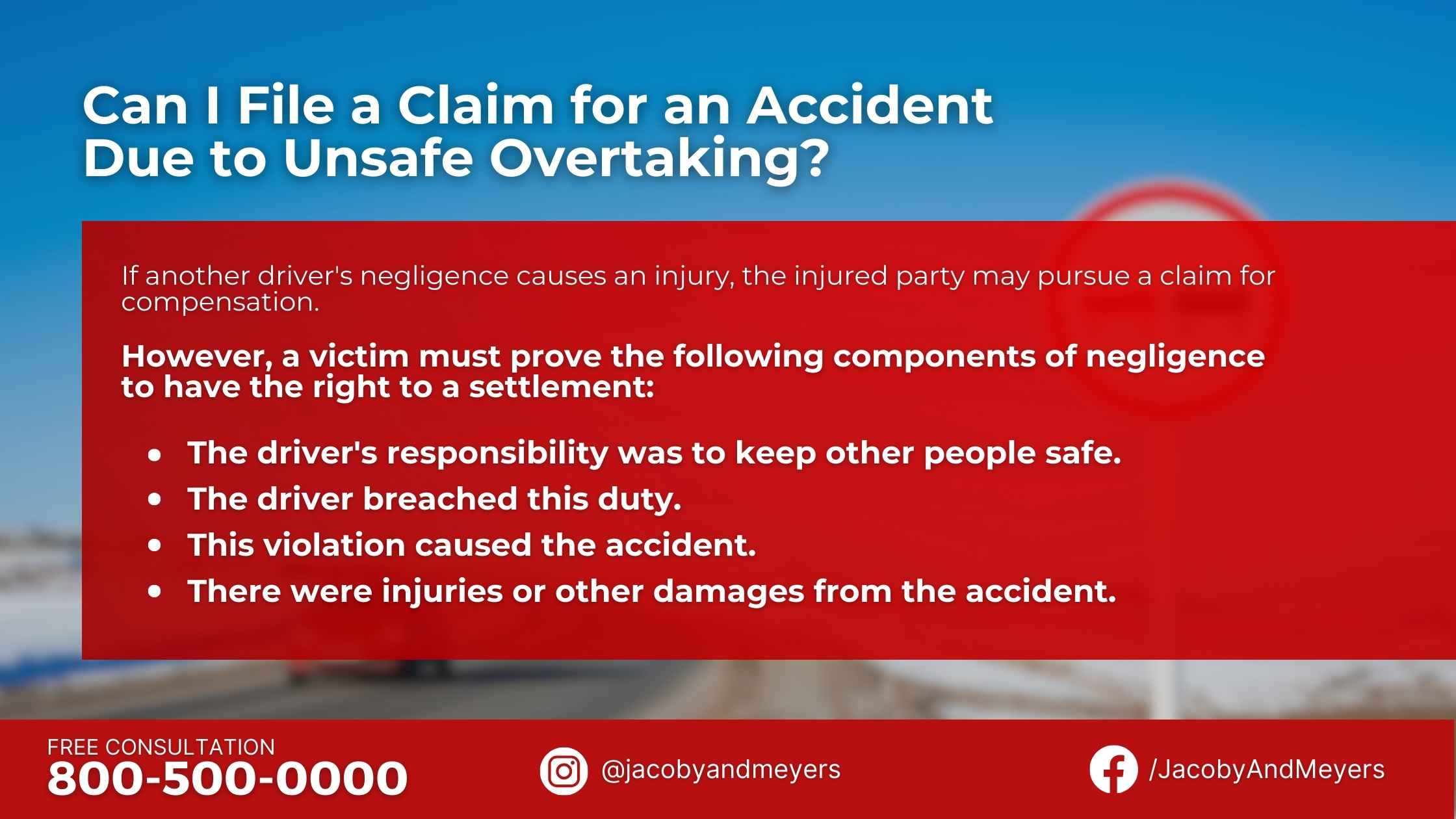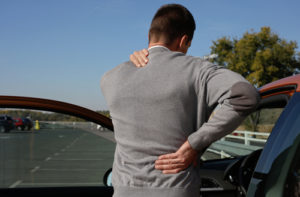When a car overtakes another and causes a crash, the driver may be liable for the damages. However, this is only true if the accident results from their negligent actions. Otherwise, other parties involved in the collision may be responsible for the damages.
Suppose you are involved in a California car crash involving an overtaking vehicle. In that case, this article will help you determine liability in such a case and what to do to protect your rights.
What Are the Dangers of Overtaking Cars?
While overtaking other vehicles is generally allowed, drivers must understand that doing so may endanger the safety of others. This is especially true if several factors are involved during overtaking. For instance, if a vehicle is overtaking on a curved path, other vehicles can obstruct the view of oncoming traffic, increasing the risk of a collision.
The following are some of the main risks connected to overtaking:
- Blind Spots: Observing incoming traffic when driving a car, especially a larger one, might be challenging.
- Obstructed View: Obstacles such as slopes, curves, and other cars can make it difficult to see approaching traffic, which raises the possibility of a collision.
- Speed Differential: If you underestimate the speed of the car you’re trying to pass, you might not have enough time to finish the move safely.
- Narrow Roads: Because there is less space, passing on a narrow road might be dangerous.
- Poor Weather: Visibility and traction might be decreased by rain, fog, snow, and ice, increasing the risk of overtaking.
- Power and Performance: Certain cars might not be able to accelerate quickly enough to pass safely within the allotted distance.
- Unexpected Lane Changes or Erratic Driving: The car being passed or other vehicles may abruptly shift lanes, or drivers may drive erratically, leading to dangerous circumstances.
- Distracted Driving: Drivers may misunderstand whether it is safe to pass another vehicle due to distractions like cell phones or other activities.
- Fatigue: When overtaking, drowsy drivers might not be able to adjust swiftly enough to changing circumstances.
In a 2020 study, about 57.2% of survey participants admitted that using a mobile device was the primary cause of their abrupt or risky lane change, with other causes of distraction accounting for 21.2% of the total. Additionally, before deciding to change lanes, drivers who glance in their side mirrors or out their windows are 4.61 and 3.85 times less likely to be involved in an accident than other drivers.
Drivers should always have a clear view of the road ahead, accurately evaluate distances and speeds, and obey traffic regulations and road markings to reduce the risks of overtaking or lane changing. It is also critical to appropriately indicate intentions and pass only when it is entirely safe.
Is Car Overtaking Illegal in California?
California allows overtaking in vehicles. However, there are several laws governing passing and overtaking, including the following:
- California Vehicle Code 21750: When one vehicle overtakes another moving in the same direction, the driver of the overtaking vehicle must move to the left at a safe distance without compromising the overtaken vehicle’s ability to operate safely.
- California Vehicle Code 21751: When overtaking and passing another vehicle traveling in the same direction on a two-lane highway, a car cannot be driven to the left side of the center of the road unless the left side is sufficiently visible and apparent of oncoming traffic ahead of it to allow the overtaking and passing to be completed without obstructing the safe operation of any vehicles approaching from the opposite direction.
- California Vehicle Code 21752: If any of the following apply, no car may be driven to the left side of the road:
- When approaching or standing atop a highway curve or grade where there is enough space for the driver’s view to be obscured to constitute a hazard in the unlikely event that a vehicle approaching from the opposite direction does so.
- The view is obscured when approaching any bridge, viaduct, or tunnel within 100 feet of it.
- While traveling across any railroad grade crossing or near one within 100 feet.
- While traveling through any intersection or getting close to one within 100 feet.
- A one-way street is exempt from the application of this clause.
- California Vehicle Code 21753: The driver of a vehicle being overtaken must safely move to the right side of the road in favor of the overtaking vehicle upon receiving an audible signal or a brief flash of headlights from the overtaking vehicle. Until the overtaking vehicle has ultimately passed, the driver of the overtaken vehicle may not speed up.
- California Vehicle Code 21754: A driver can only pass another vehicle on the right under certain circumstances. These include:
- When the vehicle being passed is turning left.
- On a highway with a wide enough lane for multiple vehicles to pass each other, especially in business or residential areas
- On a highway with clear markings for multiple lanes of traffic
- On a one-way street
- On a divided highway where traffic is restricted to one direction on each side
- Note that this section does not exempt slow-moving vehicles from keeping as close to the right side of the road as possible.
How to Safely Overtake a Car
It takes cautious preparation, focus on the road, and obedience to traffic laws to safely pass a car. The following instructions can help you pass a vehicle safely:
- Before passing another car, check your blind areas, side mirrors, and rearview mirror to ensure there are no oncoming cars or pedestrians.
- Decide on a secure area to pass, like a straight road free of intersections or obstructions.
- Change your speed to keep up with the car you’re passing. This will allow you to move into position and improve your chances of passing.
- When you’re ready to pass, use your turn signal to let others know. This will make other motorists aware of your presence and enable them to predict your movements.
- While keeping a safe distance and speed, pass the car being overtaken on the right-hand side. Steer clear of passing on the left-hand side as this might be riskier and result in crashes into other vehicles.
- After passing, check your mirrors and blind zones once more to ensure you’re clear of other cars or pedestrians.
- Once you have passed the car, return to your original lane and keep a safe distance from other moving cars.

Can I File a Claim for an Accident Due to Unsafe Overtaking?
If another driver’s negligence causes an injury, the injured party may pursue a claim for compensation. In such circumstances, the at-fault party’s insurance company will likely cover the damage costs.
However, a victim must prove the following components of negligence to have the right to a settlement:
- The driver’s responsibility was to keep other people safe.
- The driver breached this duty.
- This violation caused the accident.
- There were injuries or other damages from the accident.
Remember that there are several laws about overtaking, so, if a driver’s unsafe car overtaking and violation causes an accident, you may file a claim against them. In such a case, you must have evidence that they illegally passed, resulting in a crash.
Moreover, the following evidence can help you demonstrate negligence:
- Photographs of the accident scene
- Dash camera or surveillance footage
- Police reports
- Witness testimonies
- Medical bills and other injury-related documents
Can I Still Receive Compensation If I’m Partly Liable?
When both drivers contribute to a car overtaking accident, it can be challenging to determine who is most at fault. If you and another driver share liability in California, you can still file a claim, but you may receive a reduced settlement.
For instance, a driver failed to signal that they were overtaking. At the same time, you were drowsy during the crash, so you overlooked the car overtaking. In such an instance, you could be partially responsible for the accident.
Even if you’re partially responsible, you can still file a claim, but the amount you receive may be reduced. In this scenario, if the court finds you 30% responsible for the accident, you may receive 70% restitution, while the other driver could claim 30% compensation.
Determining liability in an accident involving overtaking cars can be complex and often leads to uncertainty. In these cases, seeking guidance from an experienced California car crash lawyer is recommended. They can thoroughly review the details of your case, assess relevant facts, and determine the responsible party for the damages you’ve incurred.
How Can the California Car Crash Lawyer Help Me?
Car overtaking accidents can be challenging, especially when the other driver’s insurance company disputes your account of the incident and blames you for the collision. However, with the guidance of an experienced California car crash lawyer, you can build a strong case and prove your innocence.
Your lawyer can help by:
- Collecting evidence to support your version of events
- Identifying the at-fault party and determining their level of responsibility
- Assessing the full extent of damages incurred
- Communicating with the insurance company on your behalf
- Taking legal action if necessary
With their expertise, skills, and resources, your lawyer can help you secure a favorable outcome for your claim and hold the responsible party accountable for their actions.
If you’re seeking a reliable and experienced car accident lawyer in California to advocate for your rights, Jacoby & Meyers is a top choice. With a team of dedicated and skilled personal injury attorneys, they are committed to ensuring you receive the justice you deserve. Unlike other firms that may only focus on securing compensation, Jacoby & Meyers prioritizes protecting your rights and is, therefore, the preferred choice for many accident victims.
With a rich history dating back to 1972, Jacoby & Meyers has consistently delivered results for its clients, securing substantial settlements and over $2 billion in settlements. Our impressive track record speaks to our dedication to our clients’ interests.
If you’ve suffered injuries in a car accident, Jacoby & Meyers is here to help. We offer free consultations to injury victims and work on a contingency fee basis, meaning you don’t pay unless we secure a settlement.
Jacoby and Meyers. Because You Deserve Justice.
Hear From Our Past Clients
Instead of relying just on our guarantees, consider what satisfied clients say about our services.
“Laura was a great help. Always explain any questions or concerns. Always in contact, following up and informing me of the process. She made everything easy to understand and was very friendly and kind. Thank you, Laura. It was a pleasure working with you. – Jeimi T.
Frequently Asked Questions
Do you have further questions regarding personal injury claims? We got you! Here are some frequently asked questions from injured victims that may help explain some aspects of your case.
- Does Insurance Cover Hit-and-Run Accidents?
- Can I File a Car Accident Claim if I’m an Undocumented Immigrant in California?
- What Happens If an Unlicensed Driver Hits Me?
- Do I Need A Police Report When Filing for a Car Accident Claim?
Works Cited
Science Direct, https://www.sciencedirect.com/science/article/pii/S0386111219300020. Accessed 4 June 2024.
California Vehicle Code 21750, https://casetext.com/statute/california-codes/california-vehicle-code/division-11-rules-of-the-road/chapter-3-driving-overtaking-and-passing/article-3-overtaking-and-passing/section-21750-driver-overtaking-vehicle-proceeding-in-same-direction. Accessed 4 June 2024.
California Vehicle Code 21751, https://casetext.com/statute/california-codes/california-vehicle-code/division-11-rules-of-the-road/chapter-3-driving-overtaking-and-passing/article-3-overtaking-and-passing/section-21751-vehicle-overtaking-and-passing-another-vehicle-proceeding-in-same-di. Accessed 4 June 2024.
California Vehicle Code 21752, https://casetext.com/statute/california-codes/california-vehicle-code/division-11-rules-of-the-road/chapter-3-driving-overtaking-and-passing/article-3-overtaking-and-passing/section-21752-driving-on-left-side-of-roadway-prohibited?q=California%20Vehicle%20. Accessed 4 June 2024.
California Vehicle Code 21753, https://casetext.com/statute/california-codes/california-vehicle-code/division-11-rules-of-the-road/chapter-3-driving-overtaking-and-passing/article-3-overtaking-and-passing/section-21753-driver-of-overtaken-vehicle-must-move-to-right-hand-side-of-highway? Accessed 4 June 2024.
California Vehicle Code 21754, https://casetext.com/statute/california-codes/california-vehicle-code/division-11-rules-of-the-road/chapter-3-driving-overtaking-and-passing/article-3-overtaking-and-passing/section-21754-overtaking-and-passing-to-right-of-another-vehicle?q=California%20Ve. Accessed 4 June 2024.
Call or text 888-522-6291 or complete a Free Case Evaluation form








